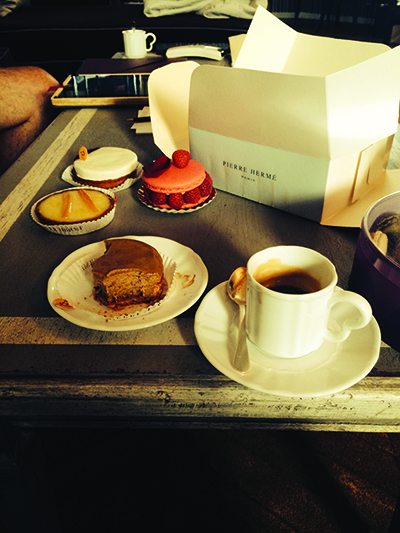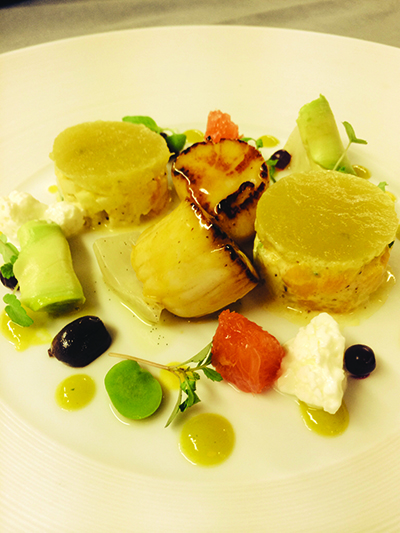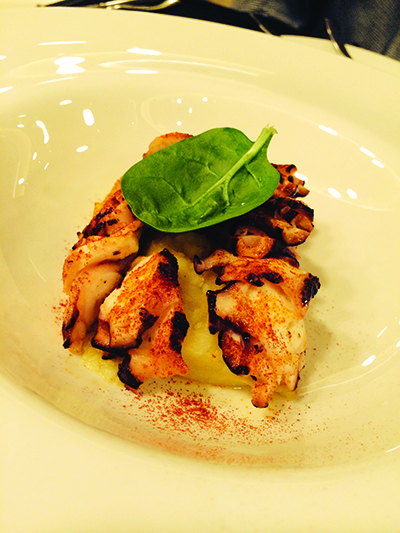Staging (pronounced stah-jing) is a term well known to many chefs. Originating from the French word stagiaire, meaning trainee, it has come to be more broadly used for chefs who travel to other cities and countries to “work” in another chef’s kitchen, dine at local eateries and absorb the local culture and surrounds. Taking advantage of a lighter schedule at Sausalito’s Murray Circle, pastry chef Ethan Howard and I decided to gather some inspiration by walking in the footsteps of some of our favorite chefs: Alain Passard, Pascal Barbot, Eric Ripert and Alain Ducasse, as well as mentors/ culinary icons Joël Robuchon, Paul Bocuse and Thomas Keller. In 12 days, we packed in four Michelin-starred restaurants and a famous open-air food market in three of Europe’s gastronomic capitals — Paris, Lyon and Barcelona.
Pastries and more in Paris.
We could blame the extra 150 euros ($208 U.S.) we spent on renting a sleek black town car, instead of the 7.50 Euros ($10.40 U.S.) it would have cost to take the Metro, on jet lag or false advertising, but truthfully, we were tired and didn’t know any better. The fact that our driver didn’t pull into the driveway of our hotel furthered our suspicions that our taxi was not quite legit. Fleeced and famished, we lugged our bags up the beautifully manicured driveway, surrounded by ornate and inviting gardens, and mustered our best French to check in to the Saint James Paris, a Relais & Châteaux property. This once stately manor has retained its charm, artwork and grandeur, yet the rooms are updated with the modern amenities one might need. A bottle of Taittinger awaited in our rooms — a good antidote to our earlier ordeal. We sipped, snoozed and were soon refreshed enough to embark on our first dinner booking.
Paris is a city of museums, many having one or more dining options. My wish list included the Mini Palais, housed in the iconic Grand Palais, as I’d heard about the menu’s approach to seasonality. Bright and airy during the day with large windows, sweeping verandas overlooking the museum grounds, polished wooden tables and whitewashed walls, the room has a relaxed, elegant country home feel. But during our visit as dusk approached, the lighting changed to a dim blue, soft sultry music filled the air, and the space took on a club-like feel that was an obvious hit with the young crowd. The food was classic French with contemporary touches: cream of carrot with ginger and lemongrass shards emerging from the fresh creamy broth; roast duck fillet with spices, candied turnips, orange, ginger and rosemary; a simple raw beef tartare with French fries that exemplified the cuisine in its simple, flawless precision. Local wines by the carafe were the perfect match, fueling enthusiasm for some evening sightseeing.

The next day, Ethan’s mission was to find the best macarons and pastries in Paris. Pierre Hermé is an internationally famous pâtisserie boutique with shops around the world. We visited the first to open in Paris located in the Saint-Germain-des-Prés. We were literally kids in a candy shop, and overindulged appropriately, walking out with a box of sweet delicacies including lemon tarts, macarons, profiteroles and more — all in the name of research.
In Paris there is a famous kitchenware shop called E.Dehillerin; it’s nearly 200 years old. I was introduced to it when I worked for Thomas Keller and he returned from a trip with palette knives from this shop for all his chefs. “This knife,” he instructed, “must be our hands.” No tongs or sharp implements could respect the ingredient as would this tool. I was keen to pay it forward with oyster shuckers and the same palette knives for my chefs back at Murray Circle. We spent over an hour exploring rows and rows of hanging copper pots, narrow aisles and basement nooks and a few hidden passages the staff alerted us to. Considering they sang “If you’re going to San Francisco …” in unison when we finally left, I’m thinking our enthusiasm was appreciated.
Dinner that night was at our hotel’s restaurant, aptly named Restaurant in Saint James Paris and led by Virginie Basselot, who was awarded her first Michelin star this year. She was trained by chefs such as Dominique Bouchet at the Crillon, Guy Martin at the Grand Véfour and Eric Frechon at the Bristol. Continuing the quest for learning, we observed the kitchen before dinner. We didn’t need to understand the language and could happily have slipped into any of the roles.
The front of the house was like an English gentlemen’s club, with wood paneling, bronze-colored fabrics and high trompe l’oeil ceilings. Each dish was a tribute to the revered techniques French chefs have handed down over the centuries. A black lace of truffles decorated many of our dishes, foie gras flourished and Pithiviers were so intricate that I was inspired to revisit some of my lessused French repertoire.
The following day began with the last lemon tart from our Pierre Hermé stash and a full itinerary, starting with a tour of markets.
The outdoor market, Marché d’Aligre, is in the 12th arrondissement behind the Bastille. It combined several markets; a street market that runs along rue d’Aligre; a historic covered market, the Beauvau Covered Food Market in the center; and a flea market that spreads out behind the square. We watched prawns scramble across the ice, so you knew they weren’t transported from oceans afar, and we exchanged stories with the farmers who had brought their freshly harvested produce to market. An elderly woman selling antiques drew my attention. It was lunchtime and she had a plate of oysters that she was slowly shucking and swallowing between nibbles of cheese and sips of wine — a very different scene from the hastily consumed work lunch we are used to in the U.S. Ethan had similar thoughts as he watched a bereted man standing at a stall enjoying steak and red wine. No cellphones to be seen here. These lifestyle glimpses are some of my richest memories from this trip — seeing people celebrate each meal as an occasion, and just life in general, whether at a cafe, restaurant or street stall.
Next to cross off the list was Bistrot Paul Bert, one of Paris’s most acclaimed bistros. We marveled as we walked through the doors at how accurately chef Thomas Keller had reinterpreted such a classic look and feel in his own Bouchon Bistro in Yountville — wicker chairs, huge potted palms, marble tables and a relaxed yet refined free-flowing feel.
Ethan’s beet salad emerged from the kitchen, a plump, moist poached egg wobbling on top of lightly wilted mache, surrounded by a rainbow of thinly sliced beets. My venison carpaccio was simple and delicious — venison, truffle and sour berries, freckled with Maldon salt. Lunch rolled on with seared cod and forest mushrooms and then steak. We left with a renewed passion and appreciation for Keller’s bistro and what it represents, transporting the diner to the streets of Paris.
After two days we had learned that dining at 7:30 in the evening probably wasn’t the best choice if we wanted to really embrace local culture and life, so at 8:30 we arrived at Pinxo, an open-style, clean and minimalistic tapas restaurant. Pig’s trotters with gremolata, crab delicately encased in lettuce speared with nut brittle, and a deconstructed paella with prawns resting precariously on a rice construction with rich tomato broth were the orders of the day. There was a festive feel to the whole occasion, and we agreed dining later was definitely the better choice.
Our “last supper” was reserved for the two-Michelin-star restaurant L’Atelier de Joël Robuchon, Saint-Germain, as it provided a chance to observe the precision of service, and execution of meals that garner two stars. An arresting black facade greeted us and we were led into the restaurant — a huge open kitchen with wraparound seating for those who wanted to watch the kitchen magic; glossy black tables with woven mats and red water glasses; modern artwork, and long glass walls, all creating a sense of sleek elegance with a fluent symmetry.
The dishes were an acrobatic feat, artistically assembled on plates that were themselves works of art. Lobster with shards of crisp apple sat on a triangular gold leaf design; venison tartare was wrapped in paper-thin venison carpaccio nursing a quenelle of caviar; veal pot stickers swam in a red poppy broth in a white oblique angular bowl. As Joël Robuchon was really the first Michelin-starred French chef to embrace Asian flavors, it came as no surprise that his dishes had such clean lines and unique flavor profiles.
Neither of us was eager to get to bed on our last night in Paris, so we located a cafe-bar a friend had recommended. The Lockwood was, upstairs, a cafe with unusually amazing coffee, and downstairs, an underground cave of a bar with dim lighting, loud music, locks displayed on uneven wooden walls and a decidedly San Francisco feel. A perfect place to sip late-night cocktails and people-watch.
Old Meets New in Lyon.
Lyon seems a contrast of worlds, illustrating in an exceptional way the progress and evolution of architectural design and town planning over many centuries, with the Rhône dividing ancient from modern. I was most enticed by the city’s ancient history from when the Romans settled, evoked by the Gothic structures and churches (I’m a church architecture junkie) on narrow cobblestone streets.
Thankfully, our hotel, the Cour des Loges, was in the historical section of the city. It consisted of four wonderfully restored Renaissance buildings, each with an internal courtyard. Highlights were the ornate glass dome, balconies reinforced with stone arched loggias and an absinthe dispenser in the hotel bar.
Here was where Ethan and I had our first official “stage,” in the kitchen of Restaurant Les Loges, with chef Anthony Bonnet. The restaurant was reminiscent of a Florentine courtyard with a marble floor and a spectacular contemporary glass-and-steel ceiling.
In contrast to the work schedule at Murray Circle, at Cour des Loges the kitchen team arrives at 9 a.m. and does preparation work until 2 p.m., then goes home until 6 p.m., when they return to the restaurant for the dinner service until the late-night closing.
We were both comfortable stepping into our roles on the line. The kitchen flow, dishes and techniques were familiar yet with small differences: ingredients such as wasabi seeds and creative use of smoke and essential oils. One dish was particularly fascinating. Chef would intricately remove the flesh from an orange, nestling foie gras into the hollowedout rind. Roasted slowly to incorporate the flavors, the piece was then served ceremoniously tableside. The server lifted the lid off the fruit, allowing a puff of steam to escape, and sprayed the succulent contents with a short burst of orange essential oil, before carefully upturning the contents on the plate and squeezing the juice over the top. The unique presentation was only surpassed by the dish’s flavor.
An exciting part of the trip for me was a pilgrimage to the market Les Halles de Lyon Paul Bocuse, created by the celebrated chef, now 88 years old. It was a shrine of food worship. Everything was in its most fresh, perfect and pristine of forms: The whole chickens remained intact with their heads and some feathers to illustrate their freshness, and the raw milk cheeses were kept at varying temperatures and humidities to best showcase their character. Needless to say, even a non-foodie would leave happy.
Chef Bocuse has five restaurants in Lyon: the main haute cuisine restaurant, L’Auberge du Pont de Collonges, a recipient of three Michelin stars, and four brasseries, each named after a region surrounding Lyon and specializing in its particular cuisine. At Le Sud (“The South”), you will find dishes like salade niçoise, osso buco, Bresse chicken tagine with lemon and fisherman’s soup. Simple and exquisite.
A visit to Lyon would not be complete without a rural exploration of the surrounding wineries. We took a relaxed one-hour drive through the countryside to Domaine du Vissoux for a planned private barrel tasting of a dozen Beaujolais. Housed in an old bucolic brick structure, Domaine du Vissoux is a family-run wine estate in the Pierres Dorées (golden stone) area in southern Beaujolais. As a gift for the occasion, I had prepared my own version of pâté en croûte. My efforts were rewarded as Pierre-Marie Chermette, the winemaker, casually unwrapped the package, laid out the contents on a brick-like mallet used for pounding in the barrel bung, turned to one of the barrels and drew out a glass for us each. He also pulled out his pocketknife and in the spirit of sharing sliced some of his own wild boar sausage for us to sample. I couldn’t have written a more authentic chef-meets-winemaker moment in a movie script.
Arriving back at the hotel, Ethan and I were humbled to find that our new friends and hosts had prepared a classic lyonnaise feast for us. Starting with snails and fresh churned butter, succulent sardines preserved in local oil, anchovies and just-shucked oysters, the protein-laden meal progressed to the richer side with creamy quenelles and tripe accompanied by the compulsory pomme puree and grain mustard. The company and food made for a perfect if bittersweet finale to our stay in France.
Barcelona Without Boundaries
Barcelona’s cuisine contains some stark contrasts to the classic French. While still rooted in fresh, seasonal ingredients, it’s playful and inventive, with fewer rules and boundaries. Our base was Hotel Cram circa 1892, in the middle of the Eixample District, close to the Paseo de Gracia, Rambla de Cataluña, Plaza de Cataluña and the Ramblas. A rooftop pool and bar, with wooden furniture and daybeds, is the center of activity day and evening and overlooks the city.

Our first meal at Ten’s Tapas Restaurant was a brilliant initiation. Entering through the Park hotel, I immediately noticed the long white bar surrounding the kitchen. Each dish was accentuated with modern and unpredicted innovation: Bloody mary ice cream with sea snails, fried smelt, foie gras with lemongrass, and plays on textures and temperatures like I’d never experienced. It almost seemed they were poking fun at themselves, while being very serious about the food, using the presentations and dishes to bring levity to the occasion.
In contrast, Moments, the Mandarin Oriental’s two-Michelin-star restaurant, is beautifully and intricately decorated in every way, from the food to the decor. The palest of pale blue ceilings matches the staff uniforms, which the marketing material aptly describes as “fifties air stewardess meets Givenchy meets Star Trek.” Moments is run by the legendary Catalan chef Carme Ruscalleda, the world’s only female chef to hold seven Michelin stars.
We opted for the Gastronomic Tasting Menu featuring numerous courses and tastes, crafted with modern technique at the highest level, but each offering not what it at first seems. Sitting on wooden holders, small cards illustrated by the chef (yes, she is also an illustrator, and a writer and artist) accompanied each presentation of dishes. One dish featured tuna tartare perched on top of glistening fava beans. Another dish, their version of potato, ham and eggs, starts with a potato chip sphere paying homage to a lusciously soft poached egg, its brilliant orange yolk ready to deliver nuggets of crispy ham draped over the chip. We also enjoyed caviar verde (green caviar), Maresme peas in a Spanish ham broth offered in a caviar tin; a selection of five cheeses on a piece of slate; and a porcini and chocolate dessert.
Two of my greatest passions were fulfilled beyond my dreams in just one day. At the Gaudi House museum, I wished I had a whole day to absorb the iconic architectural genius. My next stop was El Mercat de Sant Josep de la Boqueria. Dating back to 1217, it’s an elaborate conglomeration of everything in Spain’s culinary dictionary. Painstakingly designed arrangements of food are laid out, and one is definitely not welcome to touch: baskets upon baskets of dried mushrooms and spices, whole aisles of hanging chiles, glistening seafood — sea snails, miniature mussels, plump sardines and fish waiting to be gutted — rows of freshly squeezed juices, cured meats and hams everywhere.
All too quickly our gastronomic journey came to an end and we flew home in a blur of new memories. We had made lasting friends, and most important, came away with a revived excitement for old-world mastery of preparing, serving and celebrating food.


